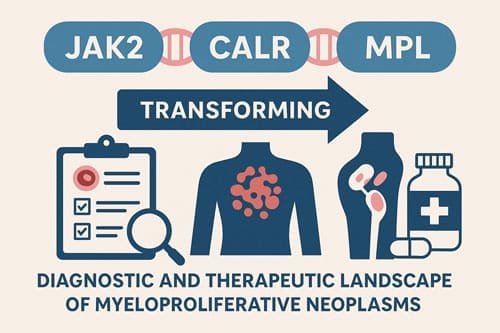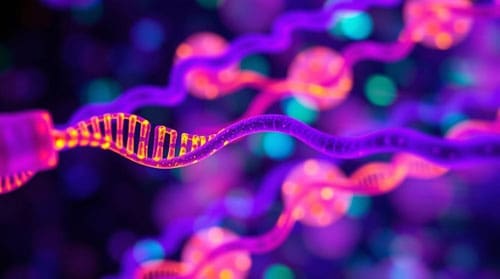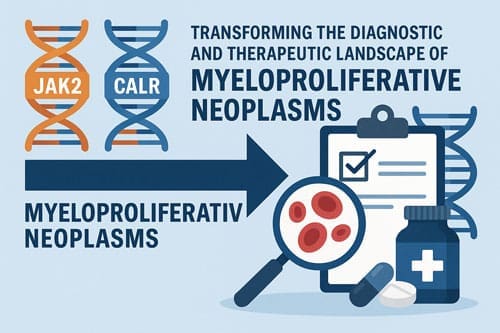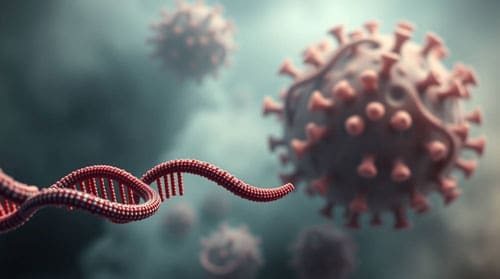JAK2, CALR, and MPL Mutations: Advanced Treatment Strategies That Work
Please like and subscribe if you enjoyed this video 🙂
Introduction
The discovery of somatic mutations in the JAK2, CALR, and MPL genes has transformed the diagnostic and therapeutic landscape of myeloproliferative neoplasms (MPNs). These mutations drive abnormal hematopoietic proliferation and serve not only as diagnostic hallmarks but also as targets for evolving treatment strategies.
Genetic testing for these driver mutations has become essential in the diagnostic workup of MPNs:
- JAK2V617F, the most prevalent driver, is present in nearly all patients with polycythemia vera (PV) and in 50–60% of patients with essential thrombocythemia (ET) and primary myelofibrosis (PMF).
- CALR exon 9 mutations are found in approximately 20–25% of ET and 30–40% of PMF cases but are virtually absent in PV.
- MPL mutations, although less common, occur in 3–7% of ET and PMF patients, frequently at codon W515.
Together, these mutations account for over 90% of MPN cases, with detection rates approaching 98% in PV and 85–90% in ET and PMF. This high prevalence enables precise molecular classification and prognostic stratification.
Despite these advances in detection, treatment outcomes remain challenging. The disease-modifying potential of JAK2 inhibitors is limited, with approximately half of patients losing therapeutic response within five years. Ruxolitinib, the first approved JAK1/2 inhibitor for intermediate or high-risk myelofibrosis, demonstrates a ≥35% reduction in spleen volume in 41.9% of treated patients compared to merely 0.7% in placebo groups. Furthermore, newer agents like fedratinib achieve similar spleen size reductions in 38.3% of patients. The median duration of spleen response to ruxolitinib is about three years, after which many patients discontinue treatment due to disease progression or intolerance. Additionally, combination therapies show promise, as evidenced by ruxolitinib with azacitidine yielding a 69% overall response rate in myelofibrosis patients. This article examines the molecular basis of these mutations and explores effective treatment strategies for JAK2 positive myeloproliferative neoplasms, including both conventional approaches and natural treatment adjuncts.

Molecular Basis of JAK2, CALR, and MPL Mutations in MPN
Molecular alterations in the JAK-STAT pathway form the cornerstone of myeloproliferative neoplasm (MPN) pathogenesis. These genetic disruptions lead to constitutive activation of signaling, resulting in excessive proliferation of myeloid lineage cells with distinct phenotypic presentations.
JAK2V617F and exon 12 mutations in polycythemia vera
The JAK2V617F mutation substitutes phenylalanine for valine at position 617, leading to constitutive activation of the JAK-STAT pathway. This results in unregulated signaling, allowing hematopoietic cells to proliferate without the need for external growth factors. In PV, this mutation leads to panmyelosis, while in ET and PMF, it contributes to elevated platelets and bone marrow fibrosis, respectively.
Less commonly, JAK2 exon 12 mutations, found in a subset of JAK2-negative PV patients are associated with erythrocytosis and a predominantly red cell phenotype. These mutations promote erythropoietin-independent erythroid colony growth and are often found in younger patients. Despite differences in clinical presentation, long-term outcomes appear similar between V617F and exon 12 mutation carriers.
CALR exon 9 frameshift mutations and MPL W515 variants
Calreticulin (CALR) mutations represent the second most common driver alterations in MPNs, occurring in 20-25% of essential thrombocythemia (ET) and 30-40% of primary myelofibrosis (PMF) patients. These mutations are virtually absent in PV. CALR mutations are almost exclusively found in exon 9 and consist of insertion/deletion (indel) variants that generate a +1 frameshift in the reading frame.
Though over 50 different CALR variants have been identified, two predominate: type 1 (p.L367fs46), a 52-bp deletion, and type 2 (p.K385fs47), a 5-bp insertion. Together, these account for more than 80% of all CALR mutations. The frameshift universally results in loss of the C-terminal KDEL endoplasmic reticulum retention motif and creation of a novel positively charged C-terminus. This transformation converts the normally negatively charged glutamic-acid-rich region into an arginine-rich domain that can directly interact with the thrombopoietin receptor MPL, activating JAK-STAT signaling independently of thrombopoietin.
MPL mutations occur in 3-7% of ET and PMF cases. The most common variants affect codon W515 in the transmembrane domain encoded by exon 10. These mutations, particularly W515L and W515K, promote constitutive activation of the receptor, resulting in cytokine-independent cellular proliferation and STAT phosphorylation. Both CALR and MPL mutations are mutually exclusive with JAK2 mutations, yet all three converge on activation of the same signaling pathway.
Clinically, CALR-mutated ET patients demonstrate lower leukocyte counts and higher platelet counts than their JAK2-mutated counterparts. In PMF, CALR mutations associate with lower leukocyte counts, lower bone marrow cellularity, and higher megakaryocyte numbers.

Triple-negative MPNs and non-canonical mutations
Approximately 10% of ET and 5-10% of PMF patients lack detectable JAK2, CALR, or MPL mutations, earning the designation “triple-negative” MPN. Triple-negative ET generally follows an indolent course, whereas triple-negative PMF carries a poor prognosis with higher risk of leukemic transformation.
Next-generation sequencing (NGS) has revealed that many purportedly triple-negative cases actually harbor non-canonical driver mutations. These include uncommon JAK2 variants (p.H538_K539delinsQL), novel CALR mutations (p.E380Rfs*51), and atypical MPL alterations (p.W515_Q516del). Moreover, mutations in LNK/SH2B3, a negative regulator of JAK-STAT signaling, may function as driver mutations in some triple-negative cases.
Beyond these, mutations in epigenetic regulators (TET2, DNMT3A, ASXL1), RNA splicing factors (SF3B1, SRSF2), and other pathways have been identified. TET2 mutations appear particularly prevalent, found in 55% of triple-negative ET patients in one cohort study. These non-driver mutations may chronologically precede or follow the acquisition of canonical driver mutations, and their presence can provide evidence of clonality, aiding diagnosis.
The identification of these non-canonical mutations has significant implications for diagnosis and treatment. NGS approaches are increasingly necessary to detect these variants and avoid misdiagnosis of triple-negative MPN. As understanding evolves, the concept of triple-negativity itself may become obsolete, replaced by a more nuanced molecular classification that informs personalized therapeutic approaches for JAK2 mutation treatment.
Diagnostic Integration of Mutation Testing in MPN Management
Accurately diagnosing myeloproliferative neoplasms (MPNs) requires a comprehensive, integrated approach, one that combines clinical assessment with advanced molecular diagnostics. In recent years, genetic profiling has moved from a supportive tool to a central pillar of MPN diagnosis, risk stratification, and treatment planning. The detection of hallmark driver mutations has become a cornerstone in identifying specific MPN subtypes, with molecular testing now considered essential to modern classification.
Notably, driver mutations are detectable in nearly all patients with polycythemia vera (PV), approximately 98% and in 85–90% of those with essential thrombocythemia (ET) or primary myelofibrosis (PMF). This high detection rate underscores the clinical value of molecular tools in everyday hematology practice.
WHO 2016 criteria and mutation-based classification
The 2016 World Health Organization (WHO) revision of the MPN classification system formalized the role of molecular genetics in diagnosis, integrating it directly into the major diagnostic criteria. For instance:
- In polycythemia vera, a JAK2 V617F or JAK2 exon 12 mutation is required as a major diagnostic criterion.
- For essential thrombocythemia and primary myelofibrosis, the presence of a JAK2, CALR, or MPL mutation is likewise included as a central criterion.
These updates reflect a shift toward genotype-driven classification, which complements traditional assessments of blood counts, marrow morphology, and clinical presentation.
The 2016 WHO update also introduced three key refinements aimed at improving diagnostic accuracy and clinical relevance:
- Lower hemoglobin thresholds for PV diagnosis—now set at 16.5 g/dL in men and 16.0 g/dL in women—were adopted to better capture early-stage disease.
- A clear distinction was established between true ET and prefibrotic/early PMF, based on detailed bone marrow histopathology, acknowledging the prognostic differences between these conditions.
- For patients without canonical driver mutations (the so-called “triple-negative” cases), the WHO recommended additional molecular testing to assess clonality and guide classification.
While molecular markers play a central role, the WHO criteria emphasize a multidimensional diagnostic approach, requiring the integration of genetic findings with clinical features, laboratory parameters, and bone marrow biopsy interpretation.
Next-generation sequencing for high-risk mutations
Although single-gene testing for JAK2, CALR, and MPL remains common in clinical practice, next-generation sequencing (NGS) is rapidly transforming the diagnostic landscape. NGS provides broad-spectrum genetic profiling, offering insights not just into disease classification but also prognosis and therapeutic decision-making.
The European LeukemiaNet (ELN) now recommends testing for a group of high molecular risk (HMR) mutations, particularly in PMF patients or those lacking driver mutations. These include:
- ASXL1
- EZH2
- IDH1/IDH2
- SRSF2
The presence of HMR mutations is associated with shortened overall survival, higher rates of leukemic transformation, and poorer response to treatment. In one study, more than 60% of triple-negative MPNs harbored other somatic mutations detectable only via NGS, enabling establishment of clonal hematopoiesis and confirming the malignant nature of the disease.

NGS-driven mutational profiling directly informs treatment intensity. Among patients with intermediate-risk myelofibrosis, HMR status often guides the decision to proceed with hematopoietic cell transplantation (HCT):
- In intermediate-1 risk patients, the detection of HMR mutations prompted early HCT consideration in 33% of cases.
- Among intermediate-2 risk patients, 47% with HMR mutations underwent early transplantation, while 53% without HMR mutations deferred transplantation based on more favorable molecular profiles.
Such stratification allows clinicians to balance treatment aggressiveness with individual disease biology
Role of allele burden in risk stratification
Beyond mutation presence, the variant allele frequency (VAF) of JAK2V617F i.e., the ratio of mutant to wild-type alleles in a patient’s cells, has emerged as a quantitative biomarker of disease burden, activity, and prognosis.
Phenotypic Correlation and Thrombotic Risk
Higher JAK2V617F VAFs correlate with specific clinical features, including:
- Increased hematocrit and white blood cell counts
- Reduced platelet counts
- Greater likelihood of splenomegaly
Importantly, VAF is also an independent predictor of thrombotic events:
- Patients with VAFs above 20% have a 7.4-fold higher risk of venous thromboembolism.
- Those with VAFs exceeding 50% are at notably higher risk of proximal deep vein thrombosis.
These findings support the use of allele burden measurement in thrombotic risk stratification, particularly in polycythemia vera and JAK2-positive ET.
Serial measurement of JAK2 allele burden offers a window into disease progression and therapeutic efficacy. Increasing VAFs over time often correlate with:
- Longer disease duration
- Rising lactate dehydrogenase (LDH) levels
- Progressive splenomegaly
Conversely, declining VAFs during therapy, particularly with agents like interferon-α and JAK inhibitors such as ruxolitinib, may reflect clonal suppression and improved disease control. Some therapies preferentially reduce VAFs by targeting different hematopoietic progenitor compartments, offering deeper molecular responses.
JAK2-Positive Myeloproliferative Neoplasm: Targeted and Adjunctive Therapies
Treatment approaches for JAK2-mutated myeloproliferative neoplasms (MPNs) have expanded considerably in the past decade, offering patients more targeted options with the potential to modify disease course and improve quality of life. The introduction of specific JAK-STAT pathway inhibitors, alongside interferon therapy and supportive measures, has created a more comprehensive treatment landscape.
JAK2 inhibitors: ruxolitinib, fedratinib, momelotinib
Ruxolitinib, the first FDA-approved JAK1/2 inhibitor for myelofibrosis, demonstrates substantial efficacy in reducing splenomegaly and alleviating constitutional symptoms. In the COMFORT-I study, 41.9% of ruxolitinib-treated patients achieved a ≥35% reduction in spleen volume compared to 0.7% in the placebo group. Long-term follow-up analysis of COMFORT-II revealed a 42% reduction in death risk compared to best available therapy. Remarkably, ruxolitinib extends beyond symptom management to potentially increase survival, with a 71% probability of survival at 3.5 years compared to 54% with best available therapy.
Subsequently approved JAK inhibitors offer alternative options with distinct profiles:
- Fedratinib (SB1518) – A JAK2-specific inhibitor showing 36% spleen response and 34% symptom response rates in the JAKARTA-1 trial. Fedratinib received FDA approval in 2019 for patients resistant to or intolerant of ruxolitinib.
- Momelotinib (CYT387) – Uniquely benefits anemic patients through ACVR1 inhibition and downregulation of hepcidin. Spleen and symptom response rates reach approximately 45% and 44% respectively.
- Pacritinib – Demonstrates efficacy in thrombocytopenic patients with less myelosuppression than other JAK inhibitors.
Although these agents effectively manage symptoms, they typically do not eradicate the malignant clone or consistently reduce JAK2 allele burden. Nevertheless, their impact on quality of life remains substantial, with ruxolitinib showing weight gain in 96% of subjects and improved total cholesterol in 97%.
Interferon-alpha in JAK2 mutation burden reduction
Interferon-alpha (IFNα) stands apart from JAK inhibitors through its ability to reduce JAK2V617F allele burden. Ropeginterferon alfa-2b (Ropeg), a long-acting pegylated-IFNα-2b, demonstrated marked JAK2V617F reduction from a median of 37.3% at baseline to 8.5% after 60 months of treatment. This allele burden reduction serves as a surrogate endpoint for clinical outcomes including thrombosis prevention and decreased risk of progression to secondary myelofibrosis.
The mechanism behind IFNα’s efficacy appears linked to its ability to deplete JAK2V617F-mutated stem cells. In laboratory studies, IFNα reduced the proportion of JAK2-mutant to JAK2 wild-type colonies in all treated patients, whereas hydroxyurea achieved this in only one of four patients. Furthermore, research indicates that IFNα preferentially activates cell cycling in JAK2V617F long-term hematopoietic stem cells, potentially causing their exhaustion through enforced differentiation.
Clinically, complete hematologic response rates of 55.8% have been reported with ropeginterferon compared to 44% with conventional therapy. Importantly, these responses appear durable, with molecular remissions sustained even after treatment discontinuation in some patients.
Exploring jak2 mutation natural treatment adjuncts
Beyond pharmaceutical interventions, mounting evidence supports the importance of lifestyle modifications in managing JAK2-positive MPNs. Notably, smoking cessation represents a critical adjunctive approach. According to the Danish Health Examination Survey, daily smokers face more than double the risk for MPN development with a hazard ratio of 2.5 compared to non-smokers. Heavy smokers demonstrate twice the risk for MPN compared to never-smokers.
The association between smoking and JAK2 mutations appears causal rather than coincidental. Smoking promotes conditions that favor mutant clone expansion, including chronic inflammation, leukocyte activation, and oxidative stress—all characteristic features of MPNs. Consequently, smoking cessation represents an essential complementary approach to jak2 mutation treatment.
Maintaining optimal body weight and addressing comorbidities like cardiovascular disease also play important roles in comprehensive MPN management, though evidence specifically linking these interventions to improvements in JAK2-positive disease remains limited.

CALR and MPL Mutations: Distinct Therapeutic Considerations
Unlike JAK2-mutated MPNs, patients with CALR and MPL mutations present unique treatment challenges requiring tailored therapeutic approaches. These mutations display distinct biological behaviors, treatment responses, and offer novel targets for emerging therapies beyond conventional JAK inhibition.
CALR mutation response to interferon and immunotherapy
Interferon-alpha (IFNα) therapy demonstrates remarkable efficacy in CALR-mutated essential thrombocythemia (ET). In a cohort study of 31 CALR-mutated ET patients, treatment with pegylated IFNα achieved hematologic responses in all patients, with median CALR mutant allelic burden decreasing substantially from 41% at baseline to 26% after treatment. Two patients even achieved complete molecular response—a feat rarely observed with conventional cytoreductive therapies like hydroxyurea. Furthermore, another study of 21 CALR-mutated MPN patients showed that 13 patients (62%) experienced a decrease in mutant allele burden with a median decline of 29% from baseline.
Nonetheless, the presence of additional mutations markedly affects treatment outcomes. Patients harboring mutations in genes such as TET2, ASXL1, IDH2, and TP53 demonstrated poorer molecular responses to interferon therapy. This finding underscores the importance of comprehensive genetic profiling before treatment initiation.
MPL mutation-specific JAK2 signaling and treatment response
MPL mutations, found in 5-10% of myelofibrosis and 1-4% of ET patients, induce stable dimerization of the thrombopoietin receptor (TpoR) that subsequently activates JAK2 and downstream pathways. The most common variants (W515L and W515K) lead to constitutive thrombopoietin receptor signaling.
In contrast to CALR mutations, MPL-mutated cases demonstrate slightly inferior clinical responses to JAK inhibitors like ruxolitinib. This diminished response occurs because JAK inhibitors target wild-type JAK2 in these patients rather than mutated proteins, limiting selectivity for neoplastic cells. Hence, alternative approaches targeting the MPL receptor directly may offer greater therapeutic potential.
CALR-targeted monoclonal antibodies and peptide vaccines
Recent advances in immunotherapy have opened promising avenues for treating CALR-mutated MPNs. The novel C-terminus of mutant CALR presents an ideal target for immunological intervention, particularly since mutant CALR is expressed on the cell surface.
Several monoclonal antibodies targeting mutant CALR have shown remarkable preclinical efficacy:
- The monoclonal antibody 4D7 selectively binds to cells expressing mutant CALR and thrombopoietin receptor, inhibiting JAK-STAT signaling and TPO-independent proliferation in patient samples. Notably, 4D7 disrupts the binding of CALR dimers to TpoR and inhibits proliferation in samples with both insertion and deletion CALR mutations.
- INCA033989, a human IgG1 antibody, selectively targets mutCALR-positive cells, reducing pathogenic self-renewal of disease-initiating cells in transplantation models. This antibody inhibits abnormal TPOR signaling without affecting normal hematopoiesis.
Alternatively, peptide vaccine approaches have entered clinical trials, including a phase 1 vaccination study with a CALR exon 9 peptide vaccine (NCT03566446). Though these vaccines induce T-cell responses against mutant CALR epitopes, clinical efficacy remains challenged by the high burden of transformed cells in peripheral blood compared to effector immune cells.
The emergence of these targeted therapies may provide viable alternatives for patients with suboptimal response to conventional treatments, potentially enabling selective elimination of mutant clones while preserving normal hematopoiesis.

Materials and Methods: Clinical Trial Frameworks and Molecular Assays
Clinical validation of mutation-targeted approaches to myeloproliferative neoplasms (MPNs) relies on rigorous methodological frameworks that bridge laboratory insights with clinical applications. These frameworks enable systematic assessment of emerging therapies for jak2 mutation treatment and other driver mutations.
Design of mutation-specific clinical trials
The European LeukemiaNet (ELN) and International Working Group for MPN Research and Treatment (IWG-MRT) have formulated consensus-based recommendations for MPN trial design. Clinical trials for MPNs follow a structured progression:
- Phase I trials stratify patients based on established prognostic categories that accurately represent disease severity
- Phase II trials for ET and PV specifically enroll patients requiring disease-directed therapy, with response measurement not shorter than 12 months
- Phase III trials increasingly incorporate molecular biomarkers for patient stratification
Importantly, clinical endpoints have evolved beyond symptom management. Phase III trials now use progression-free survival or event-free survival as co-primary endpoints to detect disease course modification. The DALIAH trial exemplifies a molecular-focused design, randomizing patients to receive hydroxyurea, IFNα-2a, or IFNα-2b with sequential assessment of 120 genes.
Molecular monitoring using digital PCR and NGS
Currently, two predominant technologies enable precise mutation monitoring in MPNs:
Digital droplet PCR (ddPCR) offers superior sensitivity compared to conventional quantitative PCR, detecting variant allele frequencies as low as 0.01%. This technique excels in detecting hotspot mutations like JAK2V617F without requiring reference curves. For CALR mutations, ddPCR demonstrates exceptional precision, detecting mutant alleles at concentrations of 0.025%.
Next-generation sequencing (NGS) provides comprehensive mutational profiling across multiple genes simultaneously. The standard threshold for positivity with NGS is typically 0.2% variant allele frequency. In comparative studies, ddPCR and NGS show strong correlation (r=0.925) in variant allele frequency measurements.
Patient selection criteria for mutation-guided therapy
Patient selection primarily considers:
- Molecular profile – identifying driver mutations (JAK2, CALR, MPL) as initial eligibility determinants
- Disease manifestations – enrolling patients with symptomatic disease requiring therapeutic intervention
- Risk stratification – considering both clinical and molecular risk factors
In practice, sequential testing algorithms typically begin with JAK2V617F assessment, followed by JAK2 exon 12 testing for suspected PV, or CALR and MPL testing for suspected ET and PMF if JAK2 is negative. Increasingly, trials utilize multigene NGS panels to establish clonality in triple-negative cases and detect high-molecular-risk mutations, fundamentally shifting from a “one-size-fits-all” approach toward mutation-guided therapy selection.
Results and Discussion: Mutation-Specific Treatment Outcomes and Resistance
Molecular resistance mechanisms undermine therapeutic efficacy in MPN patients, requiring nuanced strategies to overcome treatment failure. Recent research illuminates complex patterns in therapy resistance with important clinical implications.
JAK2 inhibitor resistance via MAPK reactivation
Even while JAK2-STAT signaling remains suppressed, MPN cells exhibit resistance to JAK2 inhibition through MAPK pathway activation. Phosphoproteomic analyzes reveal over 2,500 differential phospho-sites during type II JAK2 inhibitor exposure, with MAPK pathway activation emerging as the predominant escape mechanism. Interestingly, JAK2-STAT3/5 pathways remain suppressed, indicating alternative survival pathways beyond canonical JAK-STAT signaling.
AXL kinase overexpression plays a pivotal role in this resistance, as evidenced by altered histone occupancy promoting AP-1/GATA binding motif exposure. Correspondingly, AXL knockdown resensitizes resistant cells, while combined JAK2/AXL inhibition using bemcentinib or gilteritinib reduces IC50 values to those of sensitive cells. Alternatively, combined JAK2/MAPK inhibition with trametinib effectively halts tumor growth both in subcutaneous and systemic mouse models.
CALR mutation and interferon resistance patterns
CALR-mutated ET patients respond remarkably to interferon-α therapy, with median mutant allele burden decreasing from 41% at baseline to 26% after treatment. Even so, genetic complexity influences treatment outcomes. Patients harboring additional mutations in TET2, ASXL1, IDH2, or TP53 genes demonstrate markedly poorer molecular responses. Indeed, a study of 31 CALR-mutated ET patients revealed that all patients achieving partial or complete molecular remission had no additional mutations.
Impact of mutation order on treatment efficacy
The sequence of mutation acquisition fundamentally shapes treatment outcomes. JAK2-first patients (those acquiring JAK2 mutations before TET2) show increased sensitivity to ruxolitinib in vitro compared to TET2-first patients. Furthermore, mutation order influences disease presentation, with JAK2-first patients demonstrating greater likelihood of polycythemia vera presentation and increased thrombosis risk.
Primarily, this occurs because TET2 mutations alter the transcriptional consequences of JAK2V617F in a cell-intrinsic manner, preventing JAK2V617F from upregulating genes associated with proliferation. At the same time, initial JAK2 mutation acquisition leads to expansion of JAK2 single-mutant clones that show heightened response to JAK2 inhibition.


Conclusion
Conclusion: Toward Precision Medicine in MPN Management
Advances in molecular understanding of JAK2, CALR, and MPL mutations have fundamentally transformed the diagnosis and treatment of myeloproliferative neoplasms. The integration of mutation testing now serves as the cornerstone of MPN classification, with driver mutations detectable in 98% of polycythemia vera patients and 85-90% of ET and PMF patients [108]. Consequently, therapeutic approaches have evolved from symptom management to targeted interventions addressing specific molecular aberrations.
JAK inhibitors remain the mainstay of treatment for myelofibrosis, with ruxolitinib demonstrating not only symptom relief but also survival benefits compared to conventional therapies [109]. Nevertheless, these agents face substantial challenges through resistance mechanisms, particularly MAPK pathway reactivation [110]. The emergence of combination strategies targeting both JAK-STAT and alternative pathways accordingly offers promising approaches to overcome these limitations.
For CALR-mutated MPNs, interferon-alpha therapy has shown remarkable efficacy in reducing mutant allele burden, though additional mutations may compromise treatment response [111]. Furthermore, novel monoclonal antibodies specifically targeting mutant CALR present exciting possibilities for selective elimination of pathological clones while preserving normal hematopoiesis.
The sequence of mutation acquisition, rather than merely their presence, proves critically important for treatment outcomes and disease presentation. JAK2-first patients demonstrate enhanced sensitivity to JAK inhibition compared to patients who acquired TET2 mutations before JAK2 [112]. This finding underscores the need for comprehensive genetic profiling beyond simple mutation detection.
Future directions will undoubtedly focus on refining mutation-specific targeting strategies and developing combination approaches that address resistance mechanisms. Though complete eradication of the malignant clone remains challenging, current evidence suggests that personalized treatment selection based on specific driver mutations and their co-occurring alterations offers the best hope for improved outcomes.
The complex interplay between different mutations requires thorough genetic characterization before treatment initiation, moving beyond the traditional “one-size-fits-all” approach. Overall, the continued evolution of molecular diagnostics and targeted therapies presents unprecedented opportunities to transform MPN management from symptom control to potentially disease-modifying interventions tailored to each patient’s unique molecular profile [113].
Frequently Asked Questions:
FAQs
Q1. What are the main treatment options for JAK2-positive myeloproliferative neoplasms? The primary treatments include JAK inhibitors like ruxolitinib, which can reduce spleen size and alleviate symptoms. Interferon-alpha therapy is also effective, particularly in reducing JAK2 allele burden. Other options may include hydroxyurea, phlebotomy, and supportive care measures depending on the specific condition and symptoms.
Q2. How effective are CALR-targeted therapies for myeloproliferative neoplasms? CALR-mutated MPNs show promising responses to interferon-alpha therapy, with marked reductions in mutant allele burden observed in clinical studies. Additionally, novel monoclonal antibodies targeting mutant CALR are in development, showing potential for selectively eliminating pathological cells while preserving normal hematopoiesis.
Q3. What role does genetic testing play in managing myeloproliferative neoplasms? Genetic testing is crucial in MPN management. It aids in accurate diagnosis, with driver mutations detectable in up to 98% of cases. It also guides treatment selection, helps predict prognosis, and allows for monitoring of treatment response through techniques like digital PCR and next-generation sequencing.
Q4. How does the order of mutation acquisition affect treatment outcomes in MPNs? The sequence of mutation acquisition significantly impacts treatment efficacy. For instance, patients who acquire JAK2 mutations before TET2 mutations (JAK2-first) tend to show increased sensitivity to JAK2 inhibitors compared to those with the reverse order. This highlights the importance of comprehensive genetic profiling in tailoring treatment approaches.
Q5. What are the emerging strategies to overcome treatment resistance in MPNs? To address resistance, particularly to JAK2 inhibitors, combination therapies are being explored. These include targeting both JAK-STAT and MAPK pathways simultaneously. Additionally, novel approaches like CALR-targeted monoclonal antibodies and peptide vaccines are under investigation to provide alternative options for patients with suboptimal responses to conventional treatments.
References:
[1] – https://provider.excellusbcbs.com/documents/d/global/exc-prv-jak2-mpl-and-calr-testing-for-myeloproliferative-neoplasms
[2] – https://haematologica.org/article/view/haematol.2020.262691
[3] – https://pmc.ncbi.nlm.nih.gov/articles/PMC8764620/
[4] – https://ashpublications.org/blood/article/124/24/3529/|
33505/Therapy-for-myeloproliferative-neoplasms-when
[5] – https://ashpublications.org/blood/article/144/Supplement 1/6167/526596/Comparative-Analysis-of-NGS-and-Digital-PCR-for
[6] – https://pmc.ncbi.nlm.nih.gov/articles/PMC7463688/
[7] – https://ashpublications.org/blood/article/121/18/3692/
31277/Depletion-of-Jak2V617F-myeloproliferative-neoplasm
[8] – https://ashpublications.org/blood/article/126/24/2585/
34707/Clinical-and-molecular-response-to-interferon
[9] – https://ashpublications.org/blood/article/134/25/
2242/374997/Mutant-calreticulin-in-myeloproliferative
[10] – https://pmc.ncbi.nlm.nih.gov/articles/PMC11083661/
[11] – https://www.targetedonc.com/view/ropeginterferon-alfa-reduces-jak2-allele-burden-over-long-term-in-pv
[12] – https://pmc.ncbi.nlm.nih.gov/articles/PMC6636147/
[13] – https://www.lls.org/research/myeloproliferative-neoplasms-mpn-research-funded-lls
[14] – https://pmc.ncbi.nlm.nih.gov/articles/PMC10620561/
[15] – https://www.nature.com/articles/s41408-018-0133-0
[16] – https://pubmed.ncbi.nlm.nih.gov/27764253/
[17] – https://pubmed.ncbi.nlm.nih.gov/26486786/
[18] – https://www.sciencedirect.com/science/article/abs/pii/
S1937644821001076
[19] – https://pmc.ncbi.nlm.nih.gov/articles/PMC8982588/
[20] – https://ashpublications.org/blood/article/144/22/2336/
517724/Selective-targeting-of-mutated-calreticulin-by-the
[21] – https://www.frontiersin.org/journals/immunology/
articles/10.3389/fimmu.2023.1240678/full
[22] – https://mpn-hub.com/medical-information/mutation-specific-responses-to-cytoreductive-therapy-in-patients-with-mpn
[23] – https://www.sciencedirect.com/science/article/pii/
S2699940425000190
[24] – https://pmc.ncbi.nlm.nih.gov/articles/PMC9221914/
[25] – https://www.mdpi.com/1422-0067/20/9/2249
[26] – https://mpnresearchfoundation.org/calr-discovery/
[27] – https://pmc.ncbi.nlm.nih.gov/articles/PMC10831334/
[28] – https://pubmed.ncbi.nlm.nih.gov/37992313/
[29] – https://www.sciencedirect.com/science/article/pii/
S0006497120306868
[30] – https://www.nejm.org/doi/full/10.1056/NEJMoa1412098
[31] – https://pubmed.ncbi.nlm.nih.gov/25671252/
[32] – https://pmc.ncbi.nlm.nih.gov/articles/PMC8316412/
[33] – https://www.nature.com/articles/s41408-022-00780-9
